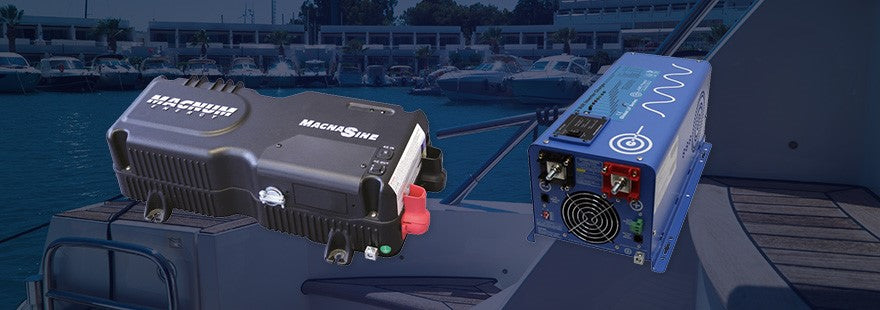How to Choose an Inverter Charger for Your Boat or RV
Many RV and boat owners are leaving large diesel generators in the dust, opting instead for inverter chargers. But before you purchase your new marine or RV inverter charger, there are a few things you need to consider, starting with a basic understanding of how inverters and inverter chargers work.
What Is an Inverter Charger?
A power inverter, in simple terms, is a device that converts low-voltage DC power to your standard household AC power. This allows you to operate household appliances, as well as electrical equipment, using the power produced by your RV or boat’s battery.
Inverter chargers generally work the same way, but include powerful battery chargers, battery monitors and remote controls. They typically also have an automatic transfer switch for when they detect another source of AC power. When detected, the inverter charger will switch from inverting to charging the batteries. Once disconnected from the AC power, the inverter charger will go back into its inverting mode.
6 Things to Consider When Choosing an Inverter Charger
Now that you have a basic understanding of what an inverter charger is, you can begin to research which model is right for you and your family. When shopping for your new RV or marine inverter charger, there are some factors you’ll need to take into account that will make your decision-making process that much easier.
1. Input Voltage
When choosing your input voltage (DC power), you should select an inverter charger that matches the voltage of the battery that will be supplying the power. So, if you currently have a 12V battery, you should go with a 12V DC inverter charger—like the 5000-watt inverter charger.
2. Output Voltage
If you live in the U.S., Canada, Mexico or parts of Latin America, chances are you’ll be using 120V AC power for your output voltage. The rest of the world uses 220-250V AC power.
3. Continuous Wattage
You’ll need to make sure your inverter charger can handle at least 1½ times the load of continuous demand you expect to have regularly. To figure this out, simply add up the wattage of each device you plan on running simultaneously. Be sure the inverters you’re considering will be able to supply enough AC power.
4. Waveform
When considering waveform, your options are pure sine wave and modified sine wave. Knowing which waveform to go with when choosing your inverter charger will depend on what you’ll be plugging into your inverter.
Pure sine waves are nearly identical to household AC power and will run electronics and appliances quietly, cleanly and smoothly. It is often preferable because it delivers a more consistent signal when compared to the choppier modified sine wave signal. Many modern devices won’t run well or even at all on a modified sine wave. When using sensitive electronics or medical devices, it is recommended you go with a pure sine wave inverter.
Modified sine waves are more inconsistent and thus do better in industrial situations. This is often the more cost-effective route to take. If you’ll be plugging in products that run on batteries, a modified sine wave inverter is a good choice.
5. Corrosion Protection
When choosing an RV or marine inverter charger, you’ll also need to consider whether or not it offers corrosion protection. This is especially true if it’s going to be used in a boat, as it will be exposed to humid and/or salty air. Do your research and look for the terms “corrosion resistant,” “rust resistant” or “corrosion protection coating.” This will safeguard and preserve your inverter charger for years to come.
6. Mounting Requirements
An inverter charger should always be installed by a professional. Understand that this device draws a lot of amps and thus has the potential for electrical fires and dangerous shorts if wired inadequately.
Keep in mind when working with a fixed-mount inverter charger that it should be installed no more than 10 feet from the battery bank. This ensures there won’t be any voltage drops or oversized wires.
While inverters aren’t ignition protected, they can be installed in a diesel engine space. Be sure to consider where you’re going to install your inverter before purchasing it. We recommend picking a location that is safe from explosive gas and is cool, dry and adequately ventilated. If it needs to be placed in a confined space, look for an inverter charger that offers fan cooling.
Shop Inverter Chargers From Boat & RV Accessories
At Boat & RV Accessories, we work hard to provide our customers with quality, top-of-the-line products designed for safety, durability and performance. Browse our wide selection of Victron Energy inverter chargers, transfer switches and more. Have a question or need more information?

